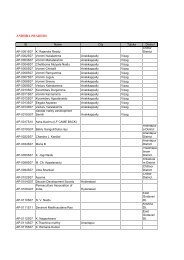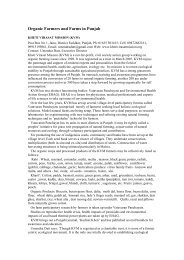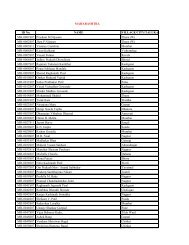Western Ghats Kokum Foundation - Organic Farming Association of ...
Western Ghats Kokum Foundation - Organic Farming Association of ...
Western Ghats Kokum Foundation - Organic Farming Association of ...
Create successful ePaper yourself
Turn your PDF publications into a flip-book with our unique Google optimized e-Paper software.
Mango and <strong>Kokum</strong> are perennial crop with a long pre-bearing period followed by<br />
several phases <strong>of</strong> bearing period namely: (1) steady yield increasing phase, (2) stabilized<br />
yield phase, (3) yield declining phase, (4) uneconmic yield. Actually flow <strong>of</strong> costs and<br />
returns in these crops spreads over a number <strong>of</strong> years with varying magnitude. The<br />
expenditure during the pre-bearing stage constitutes the investment on the crop, while the<br />
full benefit quite sometime to accrue. Investment in this long duration crop is subject to<br />
somewhat uncertain economic situation. Before making such investment, growers and<br />
financial institutions should have a clear understanding about capital and costs involved<br />
and returns likely from such a long term investment so as to know whether the investment<br />
will be worthwhile. For that all future costs and returns are discounted to present value at<br />
appropriate discount rate (14%) for productive life period <strong>of</strong> the investment. Following<br />
four criteria are generally used to decide the pr<strong>of</strong>itability <strong>of</strong> investment.<br />
1. Net Present Value (NPV)<br />
2. Benefit Cost Ratio (BCR)<br />
3. Pay Back Period (PBP)<br />
4. Internal Rate <strong>of</strong> Return (IRR)<br />
Results and Discussion<br />
As like mango, <strong>Kokum</strong> is a long duration crop. There are two broad stages <strong>of</strong> growing<br />
this. crop. First is the establishment stage and second production stage. <strong>Kokum</strong> crop<br />
requires 6 to 7 years to come to fruiting. During this stage, expenditure is incurred on<br />
raising this crop, but there is no production hence no income. This particular stage is<br />
regarded as capital cost. Production stage begins when vegetative growth <strong>of</strong> trees is<br />
completed. In the production stage, there is less production in the beginning and it goes on<br />
increasing upto 15 years and attains full, production at that stage as trees become more<br />
matured and adult. Then there is stabilization <strong>of</strong> production at this level for a pretty long<br />
period <strong>of</strong> about 40 years in case <strong>of</strong> <strong>Kokum</strong>. This is the prime period <strong>of</strong> economic or<br />
commercial production. In the establishment stage, the items <strong>of</strong> costs are labour required<br />
for various operations and purchase <strong>of</strong> input material. In production stage, the number <strong>of</strong><br />
labour units and quantities <strong>of</strong> material inputs increase as trees grow older and production<br />
increases and they remain constant during stabilization phase.<br />
Table 1: Per Hectare Cost <strong>of</strong> Establishment <strong>of</strong> <strong>Kokum</strong> upto the Year<br />
Year Amount (Rs.)<br />
First 28250<br />
Second 3781<br />
Third 3882<br />
Fourth 3654<br />
Fifth 4674<br />
Sixth 5601<br />
Seventh 6857<br />
Total 56699<br />
First year cost includes value <strong>of</strong> land.<br />
44<br />
Resource Book on <strong>Kokum</strong> (Garcinia indica Choisy)<br />
<strong>Western</strong> <strong>Ghats</strong> <strong>Kokum</strong> <strong>Foundation</strong>, Panaji - Goa





